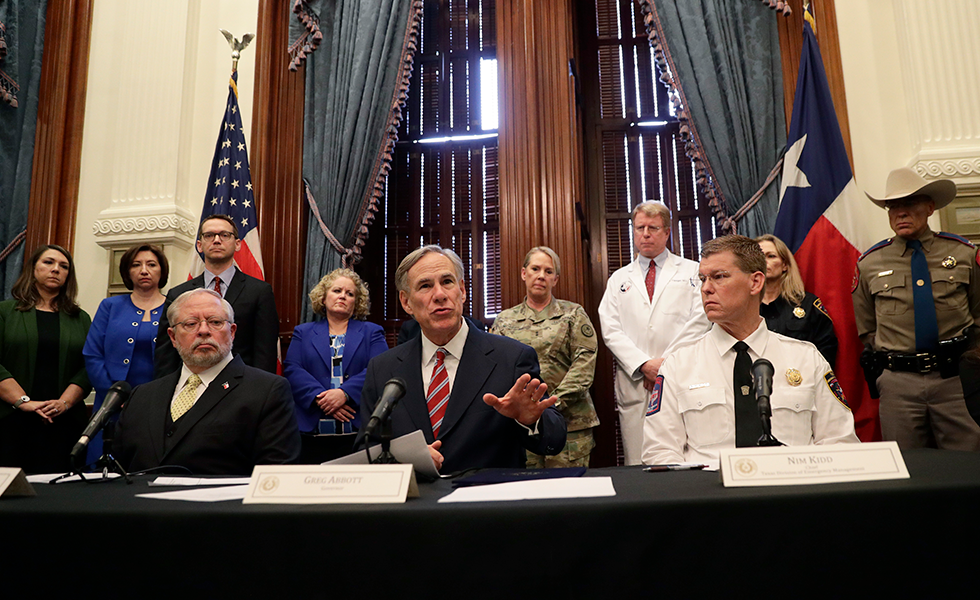
What One Texan Had to do to Get an Abortion During the Pandemic
Republican-controlled Texas is using the COVID-19 pandemic as the latest strategy in their anti-abortion playbook, and it’s affecting people’s lives.

Alison’s anxiety over her upcoming abortion kept pace with the rapidly spreading novel coronavirus. The Central Texas resident had decided to terminate her pregnancy in late March, but as public health conditions worsened around the country she was afraid it wouldn’t happen. With the global pandemic unfolding in her backyard, Alison scheduled her counseling appointment that the state requires before any abortion. Then she read the March 23 headlines: Texas’ Republican leaders were pursuing a COVID-19 abortion ban. The news gave her what she describes as a “pit of your stomach feeling.”
Alison called Whole Woman’s Health, the independent abortion provider that owns the Texas clinic where she was supposed to have a medication abortion toward the end of March. Whole Woman’s Health planned to challenge the ban in federal court, but the provider had to put 150 abortions, including Alison’s, on hold.
Alison—who, fearing professional and personal retribution, used a pseudonym to speak with the Texas Observer—was five weeks pregnant at the time. She wanted to reschedule the state-mandated counseling appointment and move forward with her abortion. Despite the ban, Whole Woman’s Health decided to continue providing medication abortions amid legal uncertainty, but the clinic couldn’t get her back on the calendar for another week. Alison couldn’t bear to wait that long, emotionally and practically. There was no guarantee that Texas politicians wouldn’t interfere after the counseling appointment and derail the actual abortion. “The longer this goes, the harder it’s going to be to make this decision,” she says.
Alison never thought she would need an abortion. Her marriage had ended in part because a doctor had told her she was infertile, and she was using contraception with her new partner. The positive pregnancy test came with “a range of conflicting emotions,” which were amplified by the spread of coronavirus in the United States. But those feelings didn’t override Alison’s certainty: She wanted to have an abortion as soon as possible.
“[Having] to jump through additional hurdles when you already feel unsafe going to the grocery store and you already feel unsafe leaving your home to go put yourself into a medical area that’s [potentially] not social distancing—it’s already an upsetting thing to have to make a decision on, especially during this time. And the hurdles and the judgment and the blocking of this is tantamount to martial law,” she says. “It’s ridiculous.”
Texas is one of the Republican-led states that has exploited the coronavirus to try to deem abortion as non-essential care, resulting in a temporary ban in the name of preserving resources. Alabama, Arkansas, Iowa, Kentucky, Ohio, and Oklahoma have similarly claimed that abortions eat up too much personal protective equipment and hospital beds. They don’t: Abortions are provided in clinics 95 percent of the time. COVID-19 abortion bans defy the American College of Obstetricians and Gynecologists (ACOG) and other leading evidence-based medical organizations’ clinical view that abortion remains “an essential component of comprehensive health care,” and a “time-sensitive” one at that. Every day counts, especially in a state like Texas, which bans most abortions at 20 weeks post-fertilization, or 22 weeks gestation under ACOG’s definition of pregnancy measured from a person’s last menstrual period.
Abortion providers teamed up with reproductive and civil rights groups to sue five states, and won temporary relief from federal judges in Alabama, Ohio, Oklahoma, and Texas. In Iowa, they reached an agreement with the state to allow some abortions to continue. Another lawsuit was filed April 13 in Arkansas. But providers’ March 30 victory over Texas didn’t last more than a day. Texas Attorney General Ken Paxton and other state officials filed an appeal that specifically targeted both “medication and surgical abortions.” The conservative Fifth Circuit Court of Appeals, which has typically opposed abortion, ruled in Texas’ favor on March 31.
When Whole Woman’s Health President and CEO Amy Hagstrom Miller spoke with the Observer on April 3, her three Texas clinics in Austin, Fort Worth, and McAllen were continuing to provide medication abortions, which she says wouldn’t require the use of any personal protective equipment. “There is a little bit of uncertainty, but for us, we feel like it’s imperative for us to be able to provide as much access as we can to patients, even during this time,” Hagstrom Miller says. Since then, the fate of the ban has been tied up in the courts. Under the latest April 10 decision, a 2-1 panel of Fifth Circuit judges, including President Donald Trump’s appointee Kyle Duncan, ruled against all abortions, except in the event that a person would exceed the state’s existing 22-week gestational limit by the April 22 expiration of Governor Greg Abbott’s executive order banning “all surgeries and procedures that are not immediately medically necessary.” On April 11, Texas abortion providers filed an emergency request with the U.S. Supreme Court to intervene and restore medication abortions while the judicial fight continues. Whole Woman’s Health has stopped medication abortions for the time being, a spokesperson confirmed to the Observer on April 13.
In late March, before the legal battles began to play out, Alison decided she couldn’t wait. She was 5 weeks pregnant, and her partner began researching abortion care options in neighboring states. Alison didn’t want to venture far from home during the pandemic, but the looming uncertainty quickly forced her to reconsider. First she called an Oklahoma clinic that couldn’t take her until mid-April, and “waiting that long was scary.” What if clinics shut down? If doctors fell ill? If the courts upheld state bans? Her apprehensions were well founded: Before a federal judge stayed the Oklahoma ban and after Alison had obtained her abortion elsewhere, the Oklahoma clinic called to push her appointment to May.
As the pandemic spread, the Guttmacher Institute found that abortion patients in Texas would face the biggest increase in travel as a result of COVID-19 abortion bans, adding more than 450 miles round trip for care. Separately, the Texas Policy Evaluation Project at the University of Texas at Austin estimated that many abortion patients “would have to travel 800 round-trip miles or more” if another state required multiple appointments that couldn’t be bridged with an overnight stay. “Finding child care, taking time off work and covering the cost of gas increase patients’ out-of-pocket expenses and are logistically challenging to arrange,” the report said.
Alison widened her search to New Mexico. The state does not have major abortion restrictions like mandatory waiting periods and had already experienced an influx of out-of-state abortion patients prior to the 2016 Supreme Court decision in Whole Woman’s Health v. Hellerstedt. The court ruled against two of Texas’ targeted regulations of abortion providers that defy medical practice and scientific evidence, but not before many of the state’s clinics shuttered. Half never reopened, and pregnant people regularly leave Texas to obtain abortion care.
Alison scheduled an appointment with a New Mexico clinic within three days. She and her partner drove nine hours, spending the night at a hotel so they would be ready for her appointment early the following morning. He wasn’t allowed inside because of COVID-19 precautions. Her medication abortion would involve mifepristone and misoprostol, a drug combination proven to be safe and effective in ending early pregnancies. The U.S. Food and Drug Administration has refused to lift what ACOG regards as medically unnecessary regulations that required the clinic to dispense mifepristone to Alison in person. As a result, the agency undermines the full potential for telemedicine abortion that would have helped flatten the pandemic’s curve by allowing Alison to connect online with a provider from her home and receive the pills in her mailbox. Regardless, Texas still bans the use of telemedicine for abortion care, which would have forced Alison to venture out to a clinic no matter what.
Alison chose to take her misoprostol in the privacy of home, so she and her partner drove back to Texas, eating the extra food they had picked up en route and stopping only for fuel. “There’s a lot of reasons to do it this way. One, it’s very effective. Two, it’s private. And frankly, [there’s] plausible deniability [if something goes wrong],” she told the Observer. Abortion is safe, and serious complications are rare, according to a 2018 National Academies of Sciences, Engineering, and Medicine report. Alison says she was prepared for that scenario: “You can go to your regular doctor or hospital and say that you’re having a miscarriage.” But that’s not without its own potential consequences, especially for pregnant people of color, who have been criminalized for self-managed abortions and miscarriages. Alison’s abortion was complete within 24 hours, and no one knew about it except for her and her partner.
Alison acknowledged that she was able to access her abortion as a privilege, even though it’s a constitutional right. “[The experience] made me angry because I’m in a position where I have options, and a lot of women aren’t right now. Whether they’re in a rural area, they’re working service jobs, they don’t have money, they don’t have supportive partners—there’s a lot of reasons that people don’t have the option [for abortion care],” she says.
Her voice broke. “This is really scary,” she says. “People should be ashamed of themselves. This is not the way that we were taught to believe in our country and believe in the freedoms of living here.”
Find all of our coronavirus coverage here.
Read more from the Observer:
-
Mi Barrio No Se Vende: San Antonio is planning to demolish its oldest and largest public housing project, threatening the future of a deeply historic neighborhood—one that anchors the city’s identity as the nation’s Mexican American capital.
-
Thousands of Migrants in Matamoros Set to be Moved to a New Encampment, Advocates Say: According to camp volunteers, Mexican immigration officials plan to move migrants to an abandoned Matamoros soccer field as early as today.
-
‘I’m in Limbo Here’: Texans Are Met with an Overwhelmed and Antiquated State Unemployment System: The safety net meant to support the second largest workforce in the country is using decades-old technology. The workforce agency was trying to replace it when the pandemic hit.


